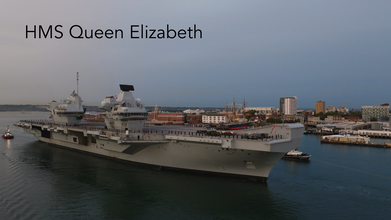
Interested In This Footage?
HMS Queen Elizabeth Leaving Portsmouth Harbour
- almost 2 years ago
- 1.0k VŪZ
9 



- 12
- Report
HMS Queen Elizabeth leaving portsmouth harbour
HMS Queen Elizabeth is the lead ship of the Queen Elizabeth class of aircraft carriers and the Fleet Flagship of the Royal Navy. Capable of carrying 60 aircraft including fixed wing, rotary wing and autonomous vehicles,[20] she is named in honour of the first HMS Queen Elizabeth, a World War I era super-dreadnought, which in turn was named after Queen Elizabeth I. The carrier Queen Elizabeth carries her namesake ship's honours, as well as her Tudor rose-adorned crest and motto.[4] She began sea trials in June 2017,[21] was commissioned on 7 December 2017 and entered service in 2020. Her first seagoing commanding officer was Commodore Jerry Kyd who was appointed in 2014 but did not take command until May 2016,[22] having previously commanded the carriers Ark Royal and Illustrious.[23] The ship is designed to operate V/STOL aircraft. The air wing will typically consist of F-35B Lightning II multirole fighters and Merlin helicopters for airborne early warning and anti-submarine warfare. The design emphasises flexibility, with accommodation for 250 Royal Marines and the ability to support them with attack helicopters and large troop transports such as Chinooks. She is the second Royal Navy vessel to bear the name Queen Elizabeth, and is based at HMNB Portsmouth.[24] Queen Elizabeth will deploy as the central part of a UK Carrier Strike Group with escorts and support ships in order to deliver carrier-enabled power projection.[25] Design and construction On 25 July 2007 Defence Secretary Des Browne announced the order for two new carriers.[26] At the time of approval the first carrier was expected to enter service in July 2015 and the budget was £4.085 billion for two ships.[27] The financial crisis led to a political decision in December 2008 to slow production, delaying Queen Elizabeth until May 2016. This added £1.56 billion to the cost.[27] By March 2010 the budget was estimated at £5.9 billion[27] and in November 2013 the contract was renegotiated with a budget of £6.2 billion.[28] The in-service date was further extended to 2020 in the Strategic Defence and Security Review in October 2010.[29] Construction of Queen Elizabeth began in 2009. The assembly took place in the Firth of Forth at Rosyth Dockyard from nine blocks built in six UK shipyards: BAE Systems Surface Ships in Glasgow, Babcock at Appledore, Babcock at Rosyth, A&P Tyne in Hebburn, BAE at Portsmouth and Cammell Laird (flight decks) at Birkenhead.[30][31] Two of the lower main blocks, together weighing more than 6,000 tonnes and forming part of the base of the ship, were assembled and joined into one piece on 30 June 2011.[32] On 16 August 2011, the 8,000-tonne Lower Block 03 of Queen Elizabeth left BAE Systems Surface Ships' Govan shipyard in Glasgow on a large ocean-going barge. Travelling 600 miles (970 km) around the northern coast of Scotland, the block arrived at Rosyth on the evening of 20 August 2011.[33] On 28 October 2012, an 11,000-tonne section of the carrier began a lengthy journey around the south coast of England, avoiding bad weather, from the shipbuilding hall at Govan to the Rosyth dockyard; it arrived on 21 November.[34] The forward island was constructed at BAE Portsmouth and attached on 14 March 2013; the aft island was attached in June 2013. The ski jump was added in November 2013,[16] leaving just the lifts and radar to be lifted into place.[16] By September 2013 Queen Elizabeth was 80% complete internally.[15] The carrier is three times the size of the Invincible-class, and has the ability to carry approximately three times as many aircraft. Despite this, Queen Elizabeth has marginally fewer crew than the Invincible-class. The ship has two superstructures, or islands, one for navigation and ship's operations and the other for flight control and aerial operations. The islands can take on each other's function if one is incapacitated. Leaving Portsmouth Harbour 08/09/2023
Up Next
HMS Queen Elizabeth aircraft carrier

- Stratus Imagery
- 1.4k VŪZ
1 - 1
- over 3 years ago
Portsmouth Night View

- SouthCoastDronesUK
- 1.0k VŪZ
0 - 0
- over 1 year ago
HMS Montrose F236 - HMS Monmouth F235 - Hardway Gosport - Waiting to be scrapped.

- SouthCoastDronesUK
- 664 VŪZ
8 - 9
- almost 2 years ago
Dquad Obsession

- Dronewolf
- 972 VŪZ
12 - 10
- over 8 years ago
Portchester Castle at Sunrise by DJI Mavic 3 PRO

- SouthCoastDronesUK
- 618 VŪZ
7 - 9
- almost 2 years ago
Behind the Falls FPV

- Dronewolf
- 2.3k VŪZ
13 - 17
- almost 9 years ago
Cunard Queen Elizabeth Cruise Ship Visits Melbourne

- Gizmo Drones
- 1.7k VŪZ
6 - 10
- almost 3 years ago
Longford Castle

- SouthCoastDronesUK
- 872 VŪZ
7 - 12
- over 1 year ago
UK's new Aircraft Carrier HMS Prince of Wales leaves Shipyard for the first time.
- Hightning McQueen
- 727 VŪZ
12 - 8
- about 6 years ago
3 Months on The Road. Thailand - Cambodia - Australia - New Zealand

- NathFowler
- 507 VŪZ
8 - 6
- over 8 years ago